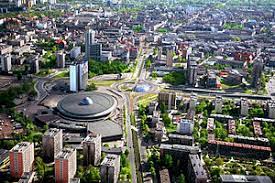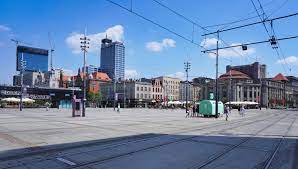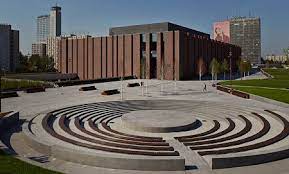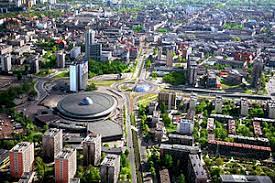History of Katowice. History of the city.

Kattowitz, Stalinogród or finally Katowice is the largest city in the Upper Silesian conurbation in terms of population. When visiting Nikiszowce and our hotel, it is worth getting to know at least briefly the history of this city.
The most important facts from Katowice's history
The first information and records about the village of Katowice date back to 1598 in the books of Father Kazimierski, the inspector of the Bogucice parish. However, the city's history is connected with several earlier Slavic agricultural settlements (dating from the 14th and 16th centuries), which are now districts of the city. These include the settlements of Dąb, the villages of Bogucice, Roździenia, Szopienice, Załęże, Ligota and Piotrowice.
The village of Katowice owes its development to the construction of the Berlin railway (1846) leading to Mysłowice. The village grew according to the design of the builder Nottenbohn. The village of Katowice was granted the status of a town in 1865 and soon became a district.
Some of the more important dates in history are: the erection of the first monumental building, the Evangelical Church on Warszawska Street (1856-1858), the construction of the neo-Gothic Church of the Blessed Virgin Mary on Mariacka Street (1870), the establishment of the industrial concern "Kattowitzer Aktien-Gesellschaft" in Katowice in 1889, followed by five well-known banks.
Under Prussian rule (from 1742), industry, especially steelworks and mines, developed in the area of present-day Katowice. At the end of the 19th century, several institutions were established here that determined the development of the young economic centre, namely the Upper Silesian Coal Convention, the Union of Mining and Smelting Industrialists, coal mines, the State Postal Directorate, the District Court and the Directorate of the Prussian-Royal State Railways. Simultaneously with the development of the city, the resistance of the Polish population against the increasing Germanization actions grew.
Later history of the city
At the beginning of the 20th century Katowice was enriched by the Municipal Theatre, built at the Market Square between 1906 and 1907. In 1906 the extension of the magnificent railway station, now no longer in use in its original character, was completed. The outbreak of the First World War did not cause damage and losses in Katowice, but rather the development of industry and a favourable economic situation, especially for the ironworks. The warfare did not affect the population, and its numerous participation between 1919 and 1921 in the three Silesian uprisings and the plebiscite action decided on the incorporation of Katowice into the reborn Polish state (20 June 1922). The city became the capital of the autonomous Silesian Voivodship, the seat of the Silesian Sejm and the Upper Silesian Mixed Commission.
The City of Katowice in the Interwar Period
The interwar years were a period of intense development for Katowice. The city became the largest economic centre in Poland, the capital of the richest region. In 1924 Katowice was the seat of as many as 53 banks, eight foreign diplomatic missions, several international concerns. Between 1926 and 1929 the following were built here: the representative building of the Silesian Parliament and the Provincial Office, and next door: the building of the Non-associated Offices (today occupied by the University of -Silesia) and the Silesian Museum (demolished by the Nazis).
The Parachute Tower in Tadeusz Kościuszko Park and the Insurgent's House in Matejki Street became symbols of the dramatic fight to defend Katowice against the German army in September 1939. On 8 September 1939, the whole of Upper Silesia, including Katowice, was incorporated into the Third Reich. The war did not cause major damage to the city's buildings, apart from the burning of the synagogue in Mickiewicza Street and the demolition of the Silesian Museum building. After liberation in 1945, the city regained its former importance as an industrial and administrative centre. An unpleasant three-year episode was the renaming of Katowice to Stalinogród in 1953.
Katowice in communist times
During the People's Republic of Poland, the city's importance as a scientific and cultural centre increased. Among other things, Katowice became a university city - the only university of the humanities in the region, the University of Silesia, was opened. Many new housing estates were built, including Koszutka, Tysiąclecie, Paderewskiego, Ochojec, Ligota, Załęska Hałda. The Provincial Park of Culture and Leisure was created. A building was erected which has become a symbol of Katowice - the "Spodek" Sports and Entertainment Hall. Katowice's recent history is associated not only with industrial and urban development, but also with great neglect of the technical and social infrastructure. One of the most tragic events in the post-war history of Katowice was the pacification of striking miners at the "Wujek" mine after the introduction of martial law. On 16 December 1981, nine strikers were shot dead. The drama is commemorated by a monument-cross at the gate of the mine.
Some interesting facts about Katowice:
- Katowice has an area of 165 square kilometres and a population of over 280,000.
- It is the 11th city in the country in terms of population and 12th in terms of area.
- The city has been awarded the prestigious title of UNESCO Creative City in the field of music. It hosts a large number of festivals, nearly 30 in the season, including the OFF Festival, Rawa Blues and Tauron Nowa Muzyka.
- In Katowice, both before World War II and after the war, the first skyscrapers were built in Poland (including the Walenty Roździeński estate, commonly known as the Gwiazdy estate, which consists of 7 skyscrapers 81 metres high!),
- There are many architectural pearls in Katowice, such as the Spodek building, the Silesian Museum, St. Mary's Church, the headquarters of the National Polish Radio Symphony Orchestra or the basilica in Panewniki, the International Congress Centre,
- The "pearl in the crown" of Katowice is the Nikiszowiec estate.




